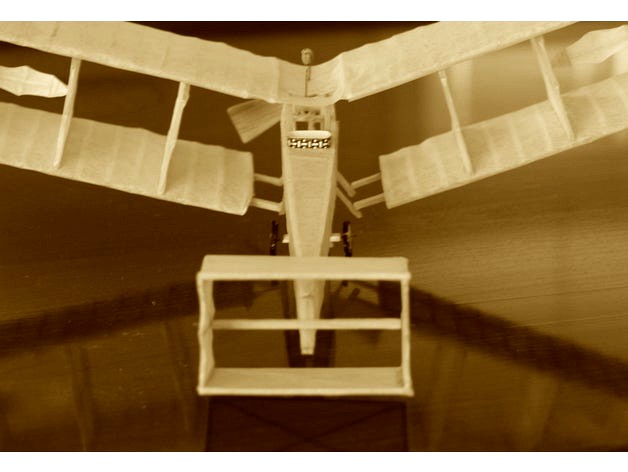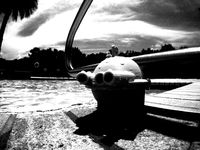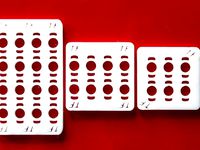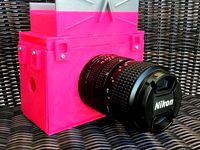Thingiverse

No 14bis by themindseye
by Thingiverse
Last crawled date: 3 years ago
No 14bis
Alberto Santos-Dumont was the Lady Gaga of late 19th-Century/early 20th-Century France. He was a performance artist of unparalleled talent. Rather than singing, however, Santos-Dumont's talent was forged in flight--human, heavier-than-air flight.
A Brazilian coffee heir, Santos-Dumont emigrated to France in 1891. In less than seven years, he had invented the world's smallest human-carrying balloon; and he named it Brazil. His lighter-than-air experiments culminated in successfully steering a dirigible around the Eiffel Tower, on October 19, 1901. Paris went bonkers with excitement and Santos-Dumont was awarded the Deutsche de la Meurth prize.
Construction of more dirigibles followed this landmark achievement. In 1905, his final dirigible, named No 14, was used to test the aerodynamics of his next aviation venture--a heavier-than-air flying machine. In a completely unorthodox manner, Santos-Dumont used the dirigible No 14 to carry his aeroplane, named after the dirigible vis-à-vis No 14bis, aloft for airworthiness tests. The aeroplane itself was an odd looking craft that featured a cumbersome canard attached to a biplane frame and propelled with a pusher engine. Yet despite its unusual looks the aeroplane was remarkably light (300 kg) and fairly petite (11.5 m wingspan).
Likewise, the performance artist in Santos-Dumont enabled him to attract huge crowds that would follow him and No 14bis throughout Paris. His final dangling dirigible test was conducted on July 22, 1906 at Bagatelle. He was happy with the results and replaced the aerial tests with ground tests. Three controls were applied to the airframe: a lever and a hand wheel for pivoting and twisting the canard acting like an elevator and a rudder control and a set of lanyards that were attached to his jacket for twisting the curtains or ailerons that were embedded in the wings between the two outside biplane cells.
In order to provide some ground mobility for the aeroplane, Santos-Dumont added three support struts under the wings and along the underside of the fuselage and a pair of delicate spoked wheels directly underneath the Antoinette engine. He also purchased a donkey named Quino for hauling No 14bis around the parade ground.
Throughout August and early September taxi trials were conducted at Bagatelle. Propellers were broken, the engine changed to a larger 50 hp Antoinette, and various holes were punched in its brilliant white linen fabric covering. By 7 September, Santos-Dumont was very close to lifting No 14bis off the ground. Realizing he needed more thrust, he replaced the propeller on 12 September and on 13 September 1906, Alberto Santos-Dumont successfully flew No 14bis into the air and France went absolutely crazy with jubilation for their "first" aviator. This flight traveled approximately 7 meters at an altitude of 1-2 meters.
Much more ambitious flights took place between 23-26 October with distances of over 60 meters and altitudes of 3 meters. These October flights earned Santos-Dumont the Archdeacon Cup for flying over 25 meters. The final flight for No 14bis was on 4 April 1907 at St. Cyr when it flew for 50 meters.
Modern day wind-tunnel testing at Le Bourget yielded a shocking result: as described by good friend Leo Opdycke, "the aeroplane should not have flown!"
You can visit a full-sized replica of No 14bis at the Museu Aeroespacial in Rio de Janeiro, Brazil: http://www2.fab.mil.br/musal/
This Model
This 3D-printable replica of Alberto Santos-Dumont's No 14bis is a 1/52 scale model. Like the original, this is a very small and delicate model. A recommended adhesive for assembly is Testors Cement for Plastic Models (No. 3512). There is an option on this model for assembling the control surfaces and propeller so that they can be operated after the construction is complete. If you are interested in using this feature, insert .032 Music Wire into the each of the moveable joints (e.g., controls, empennage, propeller, Antoninette, and struts/curtains) prior to assembly.
The struts, empennage, and controls can also be enhanced with rigging and control lines. Small openings are provided for running sewing thread (a button or carpet thread with a 50% polyester/50% cotton blend is recommended) between the control surfaces and wings. A small drop of adhesive should be added to each of these attachment points for holding the thread taut for preventing sags on the completed model.
The dihedral component has a dual use: for propping the wings up at the correct dihedral during construction and as a display stand for the finished model. Beware each side of the dihedral's four posts is keyed for proper alignment with the other posts. Lay the posts together for visually sighting which sides should be connected together.
Like the dihedral component, the work stand is a display accessory that can be optionally added to your completed model. A stand very similar to this replica was used by Santos-Dumont for propping the rear fuselage up off the ground during preflight preparations. This stand was then pulled aside after the engine had been started and Santos-Dumont was at the controls.
Finally, a wicker basket can be formed from the paper template included with the attached model files. This basket is inserted into the fuselage between the Antoinette and the hand controls. Santos-Dumont stood in this basket to fly No 14bis.
The Debate
This overview for the model would be remiss if it didn't make mention of the huge controversy that still swirls around No 14bis. This debate is an examination of the question "Who Flew First." Very similar in tone and acrimony to the argument about the virtues of competing smartphone operating systems, The Wright Brothers versus Santos-Dumont is a battle of semantics with the basic tenet being the Wrights used a catapult system for getting airborne (until approximately 1908-1911), whereas Santos-Dumont made his landmark flight unaided, lifting off from the ground (although there is an historical record that he did consider using a ramp for assisting with his take-offs: there is no record that this ramp was ever used, however).
You may recall that this debate became an international talking point during the 2016 Summer Olympic Games held in Brazil. During the opening ceremony a beautifully-crafted No 14bis replica was flown through the stadium. Does it really matter "who flew first?" Probably not, especially when you're boarding your next airliner for a holiday trip.
Reference:
French Aeroplanes Before the Great War, Leonard E. Opdycke; Schiffer Publishing, Atglen, PA, 1999; pg. 226-227.
Alberto Santos-Dumont was the Lady Gaga of late 19th-Century/early 20th-Century France. He was a performance artist of unparalleled talent. Rather than singing, however, Santos-Dumont's talent was forged in flight--human, heavier-than-air flight.
A Brazilian coffee heir, Santos-Dumont emigrated to France in 1891. In less than seven years, he had invented the world's smallest human-carrying balloon; and he named it Brazil. His lighter-than-air experiments culminated in successfully steering a dirigible around the Eiffel Tower, on October 19, 1901. Paris went bonkers with excitement and Santos-Dumont was awarded the Deutsche de la Meurth prize.
Construction of more dirigibles followed this landmark achievement. In 1905, his final dirigible, named No 14, was used to test the aerodynamics of his next aviation venture--a heavier-than-air flying machine. In a completely unorthodox manner, Santos-Dumont used the dirigible No 14 to carry his aeroplane, named after the dirigible vis-à-vis No 14bis, aloft for airworthiness tests. The aeroplane itself was an odd looking craft that featured a cumbersome canard attached to a biplane frame and propelled with a pusher engine. Yet despite its unusual looks the aeroplane was remarkably light (300 kg) and fairly petite (11.5 m wingspan).
Likewise, the performance artist in Santos-Dumont enabled him to attract huge crowds that would follow him and No 14bis throughout Paris. His final dangling dirigible test was conducted on July 22, 1906 at Bagatelle. He was happy with the results and replaced the aerial tests with ground tests. Three controls were applied to the airframe: a lever and a hand wheel for pivoting and twisting the canard acting like an elevator and a rudder control and a set of lanyards that were attached to his jacket for twisting the curtains or ailerons that were embedded in the wings between the two outside biplane cells.
In order to provide some ground mobility for the aeroplane, Santos-Dumont added three support struts under the wings and along the underside of the fuselage and a pair of delicate spoked wheels directly underneath the Antoinette engine. He also purchased a donkey named Quino for hauling No 14bis around the parade ground.
Throughout August and early September taxi trials were conducted at Bagatelle. Propellers were broken, the engine changed to a larger 50 hp Antoinette, and various holes were punched in its brilliant white linen fabric covering. By 7 September, Santos-Dumont was very close to lifting No 14bis off the ground. Realizing he needed more thrust, he replaced the propeller on 12 September and on 13 September 1906, Alberto Santos-Dumont successfully flew No 14bis into the air and France went absolutely crazy with jubilation for their "first" aviator. This flight traveled approximately 7 meters at an altitude of 1-2 meters.
Much more ambitious flights took place between 23-26 October with distances of over 60 meters and altitudes of 3 meters. These October flights earned Santos-Dumont the Archdeacon Cup for flying over 25 meters. The final flight for No 14bis was on 4 April 1907 at St. Cyr when it flew for 50 meters.
Modern day wind-tunnel testing at Le Bourget yielded a shocking result: as described by good friend Leo Opdycke, "the aeroplane should not have flown!"
You can visit a full-sized replica of No 14bis at the Museu Aeroespacial in Rio de Janeiro, Brazil: http://www2.fab.mil.br/musal/
This Model
This 3D-printable replica of Alberto Santos-Dumont's No 14bis is a 1/52 scale model. Like the original, this is a very small and delicate model. A recommended adhesive for assembly is Testors Cement for Plastic Models (No. 3512). There is an option on this model for assembling the control surfaces and propeller so that they can be operated after the construction is complete. If you are interested in using this feature, insert .032 Music Wire into the each of the moveable joints (e.g., controls, empennage, propeller, Antoninette, and struts/curtains) prior to assembly.
The struts, empennage, and controls can also be enhanced with rigging and control lines. Small openings are provided for running sewing thread (a button or carpet thread with a 50% polyester/50% cotton blend is recommended) between the control surfaces and wings. A small drop of adhesive should be added to each of these attachment points for holding the thread taut for preventing sags on the completed model.
The dihedral component has a dual use: for propping the wings up at the correct dihedral during construction and as a display stand for the finished model. Beware each side of the dihedral's four posts is keyed for proper alignment with the other posts. Lay the posts together for visually sighting which sides should be connected together.
Like the dihedral component, the work stand is a display accessory that can be optionally added to your completed model. A stand very similar to this replica was used by Santos-Dumont for propping the rear fuselage up off the ground during preflight preparations. This stand was then pulled aside after the engine had been started and Santos-Dumont was at the controls.
Finally, a wicker basket can be formed from the paper template included with the attached model files. This basket is inserted into the fuselage between the Antoinette and the hand controls. Santos-Dumont stood in this basket to fly No 14bis.
The Debate
This overview for the model would be remiss if it didn't make mention of the huge controversy that still swirls around No 14bis. This debate is an examination of the question "Who Flew First." Very similar in tone and acrimony to the argument about the virtues of competing smartphone operating systems, The Wright Brothers versus Santos-Dumont is a battle of semantics with the basic tenet being the Wrights used a catapult system for getting airborne (until approximately 1908-1911), whereas Santos-Dumont made his landmark flight unaided, lifting off from the ground (although there is an historical record that he did consider using a ramp for assisting with his take-offs: there is no record that this ramp was ever used, however).
You may recall that this debate became an international talking point during the 2016 Summer Olympic Games held in Brazil. During the opening ceremony a beautifully-crafted No 14bis replica was flown through the stadium. Does it really matter "who flew first?" Probably not, especially when you're boarding your next airliner for a holiday trip.
Reference:
French Aeroplanes Before the Great War, Leonard E. Opdycke; Schiffer Publishing, Atglen, PA, 1999; pg. 226-227.
Similar models
3dwarehouse
free

14 bis o primeiro avião
...cantada #eua #first #franca #france #outubro #paris #petropolis #pioneiro #praca_14_bis #primeiro #santos #usa #voador #voar #voo
3dwarehouse
free

Santos-Dumont's airship nº 9
...use
santos-dumont's airship nº 9. #aircraft #airship #brasil #dirigible #dumont #francia #globo #paris #santos #santosdumont
3dwarehouse
free

MARIA FELIX - ETEC ALBERTO SANTOS DUMONT
...maria felix - etec alberto santos dumont
3dwarehouse
cg_trader
free

Santos Dumont 14 Bis
...heavier-than-air aircraft. (source wikipedia) blender flightgear aircraft lowpoly challenge historical historic historic aircraft
cg_trader
free

Santos-Dumont Demoiselle N 21
...heel and a cruciform tail. (source wikipedia) blender flightgear aircraft historical lowpoly challenge historic historic aircraft
3dwarehouse
free

O Château de Bagatelle - PARIS, FR
... dumont em 1906. o lugar possui um monumento que faz menção a essas experiências. #castelo #europa #europe #france #frança #paris
3dwarehouse
free

14 bis - the first airplane of the WORLD
...#flying #france #frança #frist #october #outubro #paris #pioneers #plane #primeiro #santos #usa #verdadeiro #voador #voar #wright
3dwarehouse
free

Santos Dumont
...santos dumont
3dwarehouse
santos dumont #santos_dumont
3dwarehouse
free

AEROPORTO SANTOS DUMONT
...aeroporto santos dumont
3dwarehouse
aeroporto santos dumont
3dwarehouse
free

14bis
...ut help and without wind. it took off first in paris. #14_bis #airplane #brazil #first_plane #france #paris #plane #santos_dumont
14Bis
3dwarehouse
free

APARADOR 14BIS
...aparador 14bis
3dwarehouse
aparador 14bis incasa são paulo
3dwarehouse
free

Aparador 14bis
...aparador 14bis
3dwarehouse
3dwarehouse
free

Aparador 14Bis sem Gavetas.
...aparador 14bis sem gavetas.
3dwarehouse
3dwarehouse
free

Aparador 14Bis com Gavetas
...aparador 14bis com gavetas
3dwarehouse
3dwarehouse
free

14bis
...ut help and without wind. it took off first in paris. #14_bis #airplane #brazil #first_plane #france #paris #plane #santos_dumont
3dwarehouse
free

Aparadores
...aparadores 3dwarehouse aparador 14bis ...
3dwarehouse
free

Mesa de Jantar 14 Bis - Jacqueline Terpins
...terpins 3dwarehouse mesa disponível em diversas medidas. #hangar43 #mesadejantar #14bis ...
3dwarehouse
free

14-BIS
...avião e é brasileiro.foi feito por santos drummond. #14 #14bis #bis #f16 #mig35...
3dwarehouse
free

Aparador 14 Bis - Jacqueline Terpins
...1.50 1.80 2.00 2.20 2.40 2.60 2.80 #hangar43 #aparador #14bis ...
Themindseye
thingiverse
free

The Voyage of the Bathysphere by themindseye
...the voyage of the bathysphere by themindseye
thingiverse
a 3d replica of the 1934 bathysphere with presentation plaque.
thingiverse
free

Ped101 by themindseye
... time, and temperature displays).
the complete project code and assembly details can be found at:
http://how2-oh.github.io/ped101
thingiverse
free

ThinkFun Plate Expansion Kit by themindseye
...nd 4x4 (large) for thinkfun maker studio. this thing is one part of a three part expansion kit series: brackets, plates, threads.
thingiverse
free

ThinkFun Bracket Expansion Kit by themindseye
...egree 2x3, 130-degree 2x2, and 130+-degree 2x3. this is one part of a three part expansion kit series: brackets, plates, threads.
thingiverse
free

Weather Box by themindseye
...her box is about 100+ days.
you can find the electronics building instructions and arduino code at:
how2-oh.github.io/weather-box
thingiverse
free

piOneer by themindseye
...t was featured in issue #50 of the magpi magazine:https://raspberrypi.org/magpi-issues/magpi50.pdf
[this is a free pdf download.]
thingiverse
free

ThinkFun Threads Expansion Kit by themindseye
...and printer variance might require increasing (e.g., nuts) 1-3% and decreasing (e.g., threaded parts) 1-3% sizes for optimal fit.
thingiverse
free

AIRflex by themindseye
...y pink? as acknowledgment of breast cancer awareness month, the airflex was printed in magenta pla with a silver pla accent band.
thingiverse
free

The Thankful Turkey by themindseye
..."feathered" thanks
note: the thankful turkey is an adaptation of a commercial product, "turkey on the table."
thingiverse
free

Greeting Knob by themindseye
...torials/accelerated-aging-your-metal-bearing-3d-prints
note: greeting knob is pull handle and not an operating cylinder doorknob.
